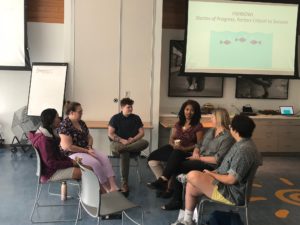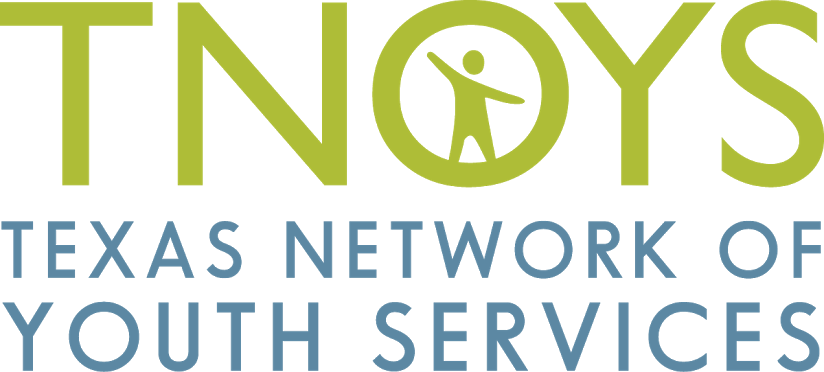
Recovery Through Participation Final Idea Share Event – September 2018
Research shows that when youth have a voice in decisions that impact their lives, it contributes to their own future success and strengthens the systems that serve them — particularly in the case of those who are recovering from trauma. But for service providers, finding ways to authentically engage youth isn’t always easy. Guided by this knowledge, TNOYS launched in 2016 a two-year collaborative pilot program – Recovery Through Participation – to help Central Texas youth service providers advance youth engagement efforts. As this project wraps up, TNOYS and our partners have learned valuable lessons about the challenges of engaging youth in services – and some strategies for overcoming those obstacles.
Recovery Through Participation was a collaborative effort between TNOYS and a dozen partner organizations in Central Texas who participated in the program activities, including TNOYS members Connections Individual and Family Services, El Buen Samaritano, LifeWorks, and STARRY. The first year of the project was focused on a series of free trainings to help the participating providers understand the benefits and options for youth engagement and best practices for implementing it. The second year focused on idea share events where the providers could come together to share their experiences and learn from each other, as well as individualized trainings for participating organizations and youth partners. Ultimately, 171 individuals from 71 Central Texas organizations were reached through the Recovery Through Participation project and project evaluations showed a shift in both thinking and action by those who participated.
As a result of its participation in the project, TNOYS member El Buen Samaritano reported hiring a youth community health worker for teen engagement and forming a youth advisory council. Connections said they have involved youth clients more as ambassadors for the agency and have included youth voice more within their trainings. And, LifeWorks reported: “We have more supervisory and managerial staff actively looking to see how youth can have more of a voice in the organization than ever before. This is a baby step, but still huge compared to where we were a few years ago.”
Below are four key takeaways from the project, including observations that were shared by participating organizations at the final idea share event in September and in project evaluation surveys:
-
Organizations want to elevate youth voice but finding the time and resources can be a challenge
Throughout the Recovery Through Participation project, it was clear that the participating youth-serving organizations understand the value of youth engagement and are eager for support in this area. This interest only grew as they learned more about youth engagement through the project trainings and events – by the end of Year 2, 88% of participating organizations said they “strongly agree” that young people’s perspectives would enhance their work, up from 79% in Year 1 of the project.
But truly integrating youth into service planning and delivery can take time, attention, patience, staff capacity and funding. Even if there is interest within the organization, actually making the commitment and taking thoughtful steps to integrate youth engagement can be difficult without organizational buy-in. As one organization shared in their project evaluation: “Sometimes, our leadership does not understand how to keep youth engaged and how much time that will take.”
-
Even small steps toward youth engagement can make a big impact
While achieving true youth engagement at an organization can be a big investment, there are small steps that can still make a difference and start building momentum. At the final idea share event, some organizations said that it could be difficult to find dedicated funding for youth engagement efforts. But one participant shared that it is possible to work around that by finding creative opportunities for youth engagement and input within other projects or efforts: “You can create a space for youth no matter what to just say what they want to,” she said. “Not everything is in black and white, so you can creatively learn how to give them that space and then how to report it.” She shared that in their required case management meetings with youth clients, they began incorporating questions and opportunities for conversation that would elicit youth input and feedback on programs and services.
Whatever an organization’s situation, if it is truly willing to build a culture that supports youth voice and engagement, it can find an option to fit its unique capacity and goals.
-
To achieve optimal youth engagement, youth must play a real role in your organization – and even be compensated for it
There are a range of meaningful ways to engage youth and elevate youth voice in an organization or program – from youth feedback surveys and focus groups to advisory groups and evaluation teams to hiring youth in peer support roles and including them on boards and councils. But to truly engage youth in a way that transforms programs and services and helps them feel valued, the youth must be seen as equal partners with valuable insights and engaged in an ongoing partnership. Recovery Through Participation helped participating organizations understand this and take the steps to make it a reality – according to the project evaluation, in Year 2, 25% of organizations said that youth are “always” paid for their work/input, up from zero in Year 1, and 50% said that youth work with their staff to plan or improve services, up from just 17% in Year 1.
Multiple organizations that participated in Recovery Through Participation sought to incorporate youth engagement into their work through formation of a youth advisory council, a group of young people that provides input on program planning and delivery. Another updated satisfaction surveys to be more youth-friendly and gather more youth input. And one organization even made strides in bringing more youth on staff, “We changed the way we brought youth on staff to a one-year internship – it helped us focus and be more intentional about how to engage youth that are actually part of our team.”
-
Working around youth’s situations and schedules is critical
One of the biggest barriers to truly elevating youth voice is being able to reach and consistently engage young people, especially those who are already facing instability in their lives. As one organization mentioned, “many youth are supporting themselves so work and other needs have to be prioritized.” This is one area where compensating youth for their time can make a difference, so that youth aren’t forced to choose between paying jobs and playing a role in your organization.
Many youth also have trouble finding transportation or maintaining consistent methods for communication. In the final idea share event, some organizations mentioned alternatives to regularly scheduled, in-person meetings to make it easier for youth to engage, such as using technology such as text messages to gather input. Another organization shared that, because they knew attendance at their youth leadership council would be difficult, they chose to make each meeting project-based, so that even if a youth participant could only come to one meeting, they could leave feeling like they had contributed something to the larger effort.
TNOYS and partners saw real growth and benefits to the Recovery Through Participation project in Central Texas. If you are interested in bringing Recovery Through Participation’s training and technical assistance program to enhance youth engagement there, please contact Lara O’Toole, TNOYS’ Director of Training and Program Development at lotoole@tnoys.org.
